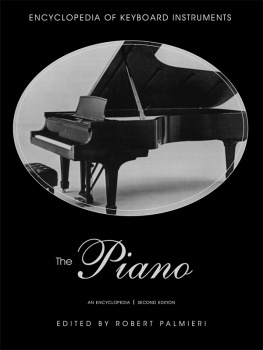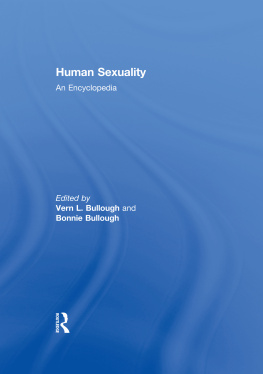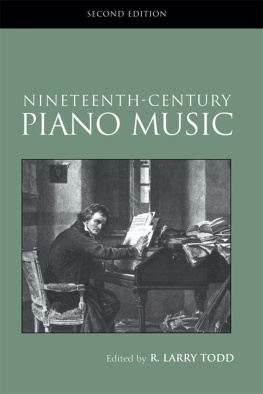In honor of the Paduan artisan, Bartolomeo Cristofori, who started it all.
LIST OF ILLUSTRATIONS
Keyboard ranges
The generation of a sine-wave
The principle of constructive and destructive interference
Standing transverse wave with nodes and antinodes
Resultant wave form of the fundamental and first two overtones
Resultant wave form of the first six partials of a tone
Oscillograph trace of a piano sound and the resulting envelope
Damped vibration
Decay curve for a1 (trichord)
Beats
Decay curve for AAA (monochord)
Decay curve AA (dichord)
Resonance of the soundboard
Grand piano action (contemporary) and surrounding parts by Steinway & Sons
Anglo-German action
Down-strike action by Pape, 1839 (from the patent)
English Grand Action by John Broadwood & Sons, 1795
Repetition Action with Double Escapement by Erard, 1822
Upright Pianoforte Action by Domenico Del Mela, 1739
Upright (Vertical) Piano Action (contemporary) by Baldwin
Upright Tape-Check Action by Wornum, 18421852
Agraffes
Duplex Scale by Steinway & Sons
The American Ampico reproducing piano
Grand pianoforte by Ludwig Bsendorfer
Clockwork-driven barrel piano
Boardman & Gray
Bridge
Frederic Horace Clark and his Harmonie-Piano
Earliest extant Cristofori Pianoforte, 1720
Scipione Maffeis diagram of the Cristofori action
Harpsichord Jack
Cristoforis action for his pianoforte of 1720
Upright Pianoforte (1739) by Domenico Del Mela
Vertical (Upright) Pianoforte Action by Domenico Del Mela, 1739
Beethoven, Waldstein Sonata Op. 53
Legato octaves
Sliding
Double thirds
Pyramidenflgel [Pyramid grand] 1745by Christian Ernst Friederici
Action by Domenico Del Mela
Claviharpe by Johann Christian Dietz, 1814
Square piano by John Broadwood & Sons
The Technicon by James Brotherhood
The Piano Dactylion
A set of keys rests on a keyframe
Advertisement for Krakauer Bros
The MirrApiano ca. 1950
Automatic piano-orchestrion
Weber expression piano
A view of overstringing (or cross-stringing) in an upright piano
Square piano by Jean-Henri Pape (1840)
Table of Partials
Mozart, Piano Concerto in C Major. K. 503
Mozart, Fantasia in C Minor, K. 475
Debain Piano Mcanique
Grand piano pinblock
Frequencies of the tonal scale of a piano
Cast iron plates
Push-up Player Piano
Key-top player
Prellmechanik without escapement
Prellmechanik with escapement
Prellmechanik with adjustable escapement
Regulating the action
Section of Baldwin grand piano action
A Duo-Art reproducing piano
Reproducing cabinet player action
Ribs
Square piano by William Rolfe and Sons
Piano-Orchestrion
A John Longman automatic piano
Square piano by Longman & Broderip
Square piano by Broadwood
Concert Grand by Steinway & Sons
Hand-turned barrel piano
Yamaha DX1 Programmable FM Digital Synthesizer
Tangent action by Jan Skrski
Fotoplayer
Number of beats per second for fifths, fourths, and thirds
An example of a tuning sequence
Upright piano
Hupfeld Phonoliszt Violina
Virgil Perfected Practice Clavier
An advertisement of the Virgil Practice Clavier
Welte reproducing cabinet piano
INTRODUCTION
When the Paduan instrument maker Bartolomeo Cristofori devised his first pianoforte, it is doubtful that he foresaw the overwhelming universal acceptance it eventually achieved. The instrument hit its peak in development and production in the nineteenth century but has continued to maintain its prominent position in the concert world and the home. This ability to endure shows us how vital the instrument has been to our musical environment. The piano celebrated its 300th anniversary in the year 2000, and to help honor the event the first edition of this volume has been updated. The piano volume of the Encyclopedia of Keyboard Instruments highlights the pianos long evolution up to the year 2002, when this second edition was completed.
One will find many subjects that are explored in depth. On the other hand there are subjects that warrant only simple definitions. An earnest attempt has been made to see that new information regarding the piano has been incorporated. In selecting the topics for this volume, every effort was made to be as comprehensive as possible; it is not possible, of course, to cover all piano companies, all piano makers/builders, all countries that produce pianos, and so on. We did, however, attempt to include the most important builders and companies.
The composers with entries in the piano volume are there because they had a direct or indirect influence on the development of the instrument, not because they wrote piano music. This volume deals primarily with the instrument itself, although one will find a few ancillary topics, for example, piano music, pedagogy, technic, touch, and the like.
The reader will find birth/death dates in the index for most persons mentioned in the volume. Dates were only entered in the text when pertinent to that article. The index will also be useful in locating the many other piano builders/makers and piano companies that are mentioned in the text but not examined in depth. The index is helpful in finding the many individual parts of the piano and where they are discussed. As a cross reference aid, items in the text that are in small caps are article titles and one can investigate further by going directly to the item so marked.








